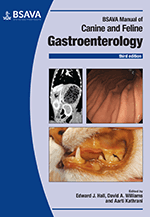
Full text loading...

This chapter describes the structure and function of the liver and gall bladder, including differences between dogs and cats, and considers the pathophysiology, diagnosis and management of hepatobiliary diseases.
Liver: hepatocellular and biliary tract disorders, Page 1 of 1
< Previous page | Next page > /docserver/preview/fulltext/10.22233/9781910443361-3e/BSAVA_Manual_Gastroenterology_3_9781910443361-3e.37a.244-267-1.gif

Full text loading...








